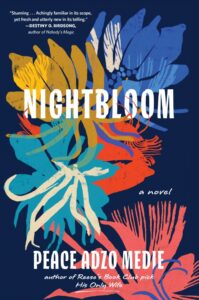
Violence Against Women: Where Fact Meets Fiction
Peace Adzo Medie on Writing and Researching Gender Violence in West Africa
For the past fourteen years, I have studied violence against women. While this form of violence is a global problem, I have focused my research on countries in Africa. This work has generated important insights that continue to inform both my fiction and non-fiction writing.
Nightbloom, my second novel, tells the story of Akorfa and Selasi, two cousins who start life as best friends in Ghana. Over time, a rift develops and deepens as the girls graduate from boarding school and Akorfa leaves to study medicine in the US. It is only when the cousins are reunited many years later that they begin to uncover the family secrets that helped drive them apart.
I began writing Nightbloom in 2018, as I was also finishing my academic text Global Norms and Local Action: The Campaigns to End Violence against Women in Africa. Naturally, violence against women, particularly sexual violence, was on my mind a lot. It soon became clear that it was a theme I wanted to explore in the novel—how and why it happens, how it affects the victims, and how the response by those closest to these victims can ameliorate or exacerbate the problem.
It was vital to me to centre the voices of survivors of sexual violence and this shaped the way I thought about structure and form.
One objective of my research has been to understand the decisions that women make after experiencing sexual violence because understanding these decisions is key to creating institutions and norms that prevent violence and that serve and support victims. In Liberia and Côte d’Ivoire, where I have worked the longest, I have interviewed over three-hundred people, including many survivors of sexual violence.
One of the first things I noted is that most people were deciding not to file police reports. This was not surprising; sexual violence is underreported in most countries around the world. However, I expected to hear that this underreporting was mostly caused by a distrust of the police. While the police were an issue, what mattered most for women was how their community would respond. They told me that the fear of being blamed, shamed, and stigmatized for what they had experienced was what really deterred them from disclosing sexual violence. In the cases where victims did receive support from relatives and friends, they often changed their mind and filed an official complaint.
It became clear to me as I conducted this study that survivors wanted to tell their story, and not only to relatives and friends. I had expected that, because of how traumatic it can be to recount the experience of sexual violence and its aftermath, interviewees would not want to say much to me. I ended up surprised at how generous survivors were with their time and how much they revealed to me. Many gave me a detailed account of the attack and explained how their life changed after. In Abidjan, B, a 24-year-old seamstress, described being tortured and raped by a male friend she was visiting. She initially decided not to tell anyone because she was afraid of being laughed at and blamed for going to his house. D, a 22-year-old hairdresser, was weighed down by the finger-pointing she endured in her neighborhood in Abidjan where people had begun to refer to her as “the girl they raped.” And though it was not easy for them, others told me of similar experiences.
My own perceptions shifted as time and again I witnessed their openness in a society where sexual violence is often shrouded in secrecy. Some survivors even found our conversations cathartic; there was a certain amount of relief in recounting the incident. Some had few people they could trust not to judge them. Furthermore, for many survivors, telling their story is a first step to getting justice and to healing. And sharing it with someone who listens and recognizes the gravity of their trauma signaled to them that they were not alone, that their story mattered, that they were not to blame, and had no reason to feel shame.
Knowing this, I felt it essential to highlight their words in my academic writing—to give them their own space on the page. While in my analysis I of course sought to identify commonalities across experiences and underlying factors that caused these experiences, I did not want to lose the individuality of their voices. I wove their quotes through the text, using them to illustrate my theoretical and analytical insights. I believed this device could better show the reader the devastating effect of this violence.
The need to highlight the words of survivors remained important as I wrote my novel, Nightbloom. Though the story and characters are fictional, it was vital to me to centre the voices of survivors of sexual violence and this shaped the way I thought about structure and form. Using multiple perspectives enabled me to show how this violence often goes unnoticed and how the silence—often enforced by those who should support the survivor to speak up—enables offenders. I was able to show how two survivors find a way to break through with their stories. But their words are far from identical. The ease with which they flow, the tones and rhythms, the depth and details provided, the resolution pursued, all demonstrate the complexity and tension that characterizes the experience of sexual violence.
Creating a world in which survivors have a degree of justice and happiness helps me to cope with the anger and sadness that I have experienced.
For the most part, I enjoy the pure creativity of writing fiction. The chance to imagine and construct every aspect of the story. With Nightbloom, however, I knew that also meant I would have to write the act of sexual assault. I knew even before I began writing that it would be difficult to do. Spending so much of my time talking, thinking, and writing about violence had already taken so much of an emotional toll that when writing my first novel, His Only Wife, from 2012-2017, I had one rule: there would be no physical or sexual violence. But Akorfa, Selasi, and their story had lived loudly in my head for so many years that not writing the book had begun to feel like I was trying to stop a flood with my bare hands.
As expected, imagining an incident of sexual assault was painful; I grieved for my characters and what they suffered as I wrote. But unlike in my research, I had some control over the story. I exercised it by describing the act only briefly, giving the reader enough detail to understand what happened but not asking them to spend page after page reading about the assault. I instead made the reader a witness to life after, showing how a person survives, experiencing joy, love, success, loss, disappointment, and failure.
In Nightbloom I was able to give my characters so much life outside of the assault. But it is different in my research. Because the people I study are real, and because my conversations with them revolve around their experience of sexual assault such that even the high points of their stories are around the incident (e.g., the perpetrator being arrested and prosecuted), they are forever linked to this act of violence in my mind. I still have a vivid recollection of some of the conversations I have had over the years: the sadness in the eyes of survivors; the anger and disgust on the face of a woman who was raped as a teenager, as she described her attacker. Therefore, while I found a way to decenter the assault in fiction, it has been impossible to do so in my research. Interestingly, writing fiction is one way that I have dealt with these memories. Creating a world in which survivors have a degree of justice and happiness helps me to cope with the anger and sadness that I have experienced while conducting this study.
As a scholar, I seek to generate and share knowledge that contributes to changing norms, policy, and practice. As a novelist, I am interested in wielding words, voice, and structure to creatively tell stories. Nightbloom allowed me to marry my scholarship with my art. I can only hope that this work of imagination helps readers to better understand the real causes and effects of violence against women, and that this understanding will lead to action that makes a positive difference in girls’ and women’s lives.
__________________________________

Nightbloom by Peace Adzo Medie is available from Algonquin Books, an imprint of Hachette Book Group, Inc.
Peace Adzo Medie
Peace Adzo Medie’s debut novel, His Only Wife, was a New York Times Book Review Editors' Choice, a New York Times Notable Book of 2020, and a Time Magazine Must-Read Book of 2020. It was also a Reese’s Book Club pick. Her book, Global Norms and Local Action: The Campaigns to End Violence Against Women in Africa, was published by Oxford University Press in 2020. She has won numerous awards for her scholarship and has held several fellowships, including the Oxford-Princeton Global Leaders Fellowship. She holds a PhD in public and international affairs from the University of Pittsburgh and a BA in geography from the University of Ghana.



















